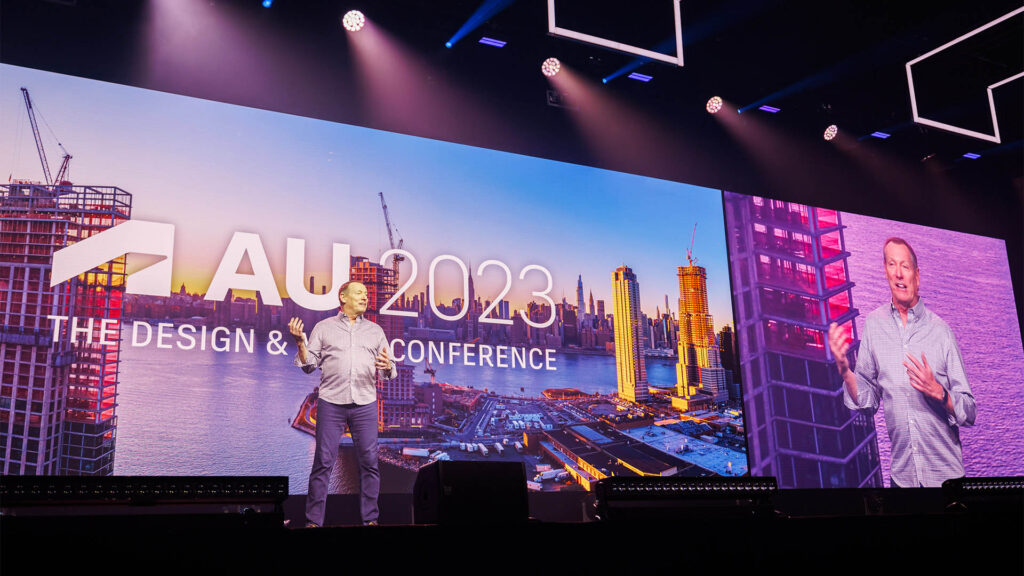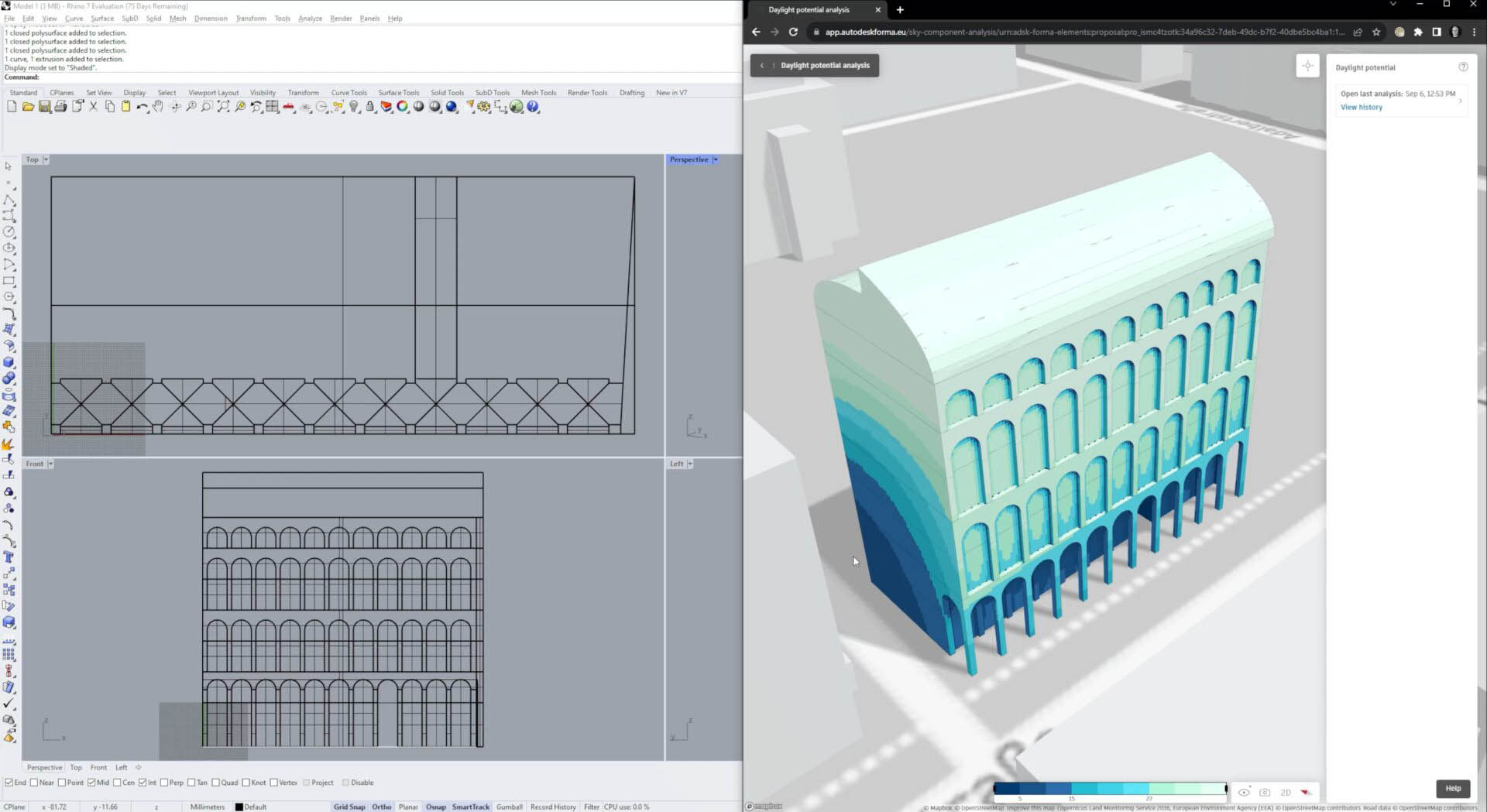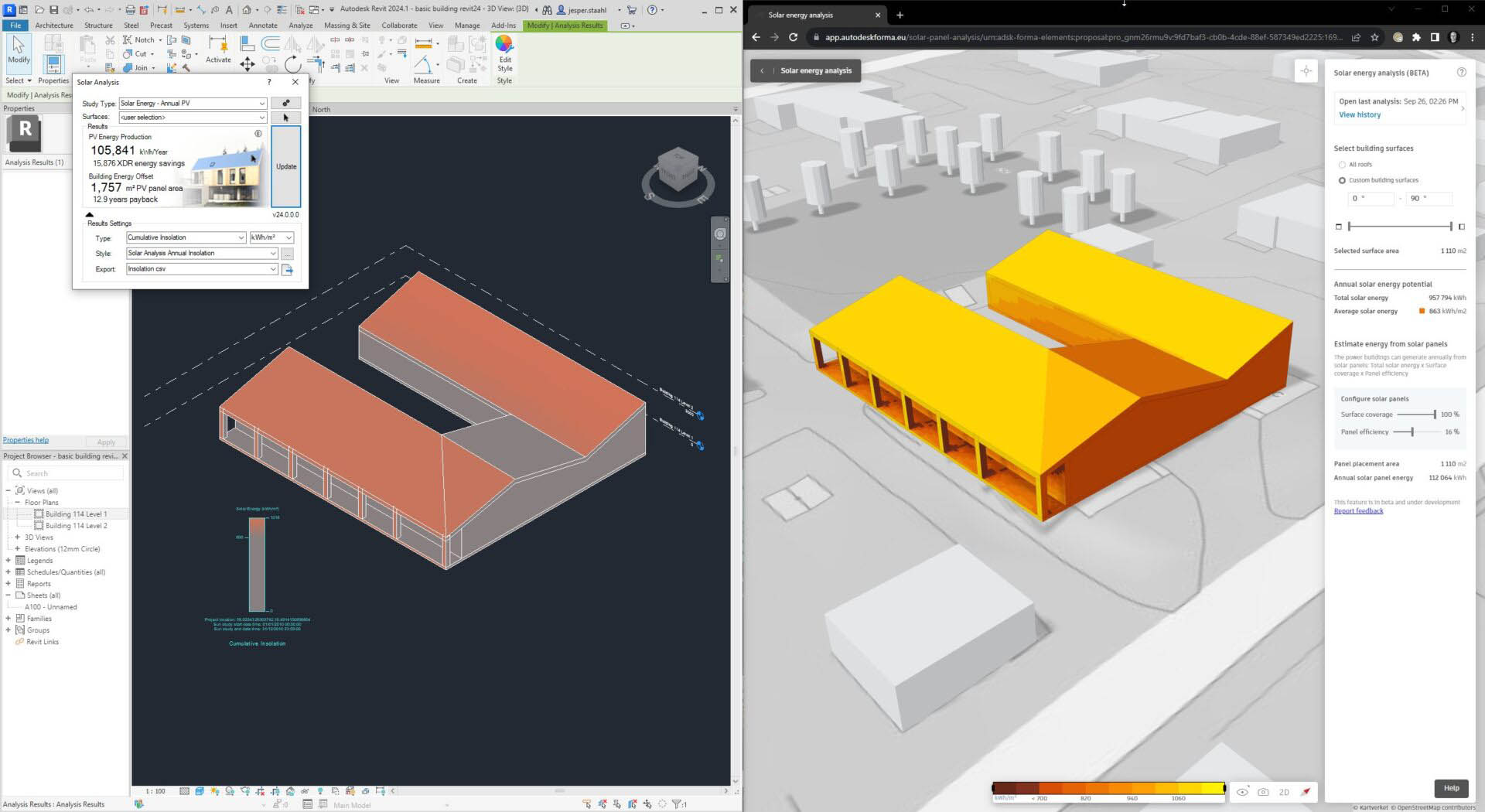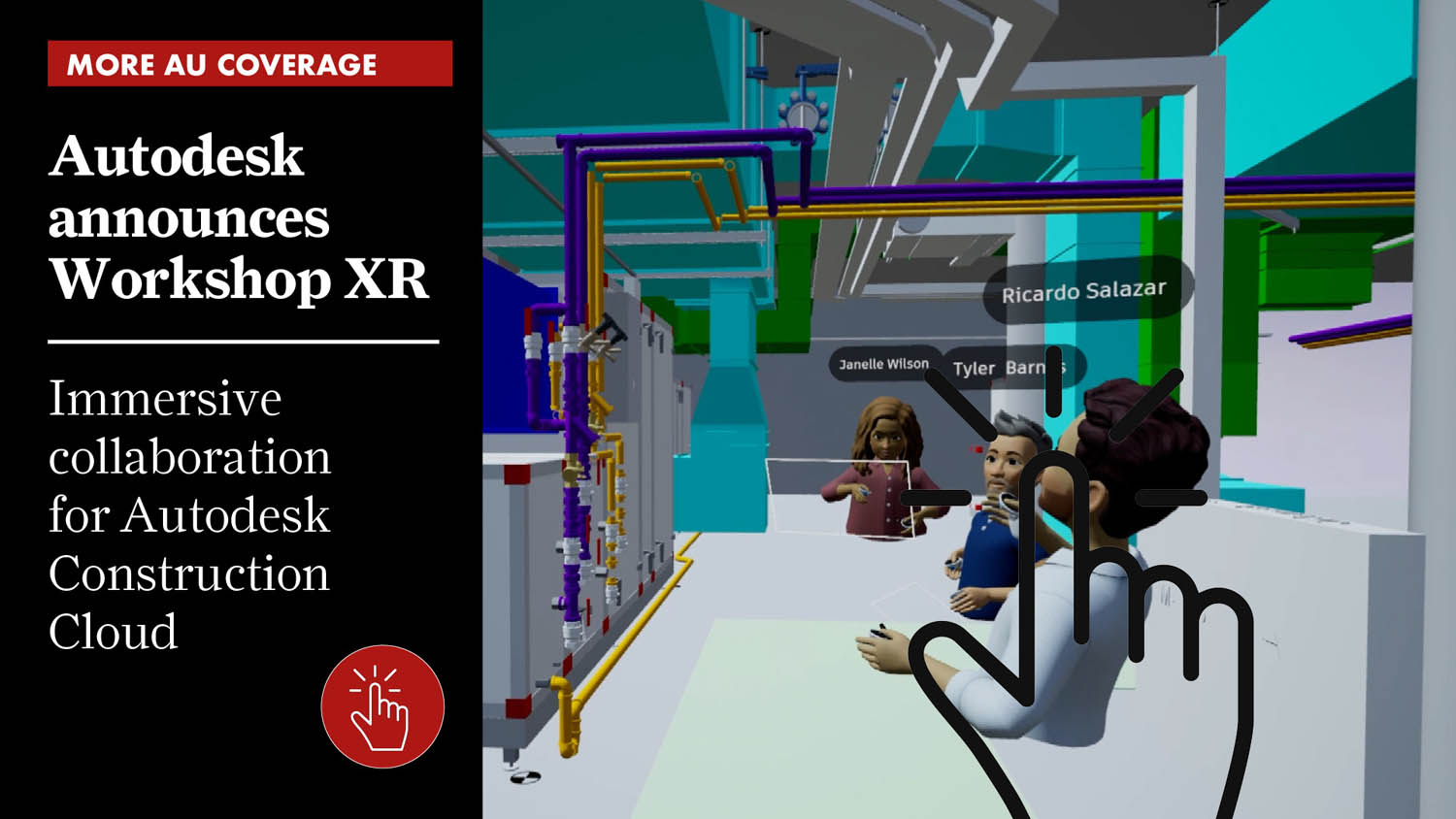At Autodesk University, Autodesk made its big play for AI, with granular data at the heart of Forma, its next generation AEC cloud-platform set to play a critical and possibly controversial role. Martyn Day and Greg Corke report
One of the exciting things about Autodesk University (AU) is that you never know quite what Autodesk will launch or focus its stage time on. In May 2023, Autodesk released Forma, its next generation cloud-platform for AEC, so we were expecting more on this, and Autodesk didn’t disappoint, while also elaborating on its new granular data model, upon which Forma is built. Furthermore, the main spotlight was on Artificial Intelligence (AI), its influence, and the advancements made by Autodesk in this sector.
From the get-go, Autodesk CEO, Andrew Anagnost, brought AI into focus, addressing the audience, “You know that that future that all of us thought was going to happen, sometime in the future? …it is already happening. We’ve seen governments struggling to regulate it, schools are uncertain how to contain it, and Hollywood was going on strike over it. It is affecting our view of what’s real. For better or worse, AI has arrived.”
In previous keynotes, Anagnost has speculated that AI and automation will create more jobs, as almost all other impactful technologies have done. However, he recently admitted on Bloomberg TV in April 2023 that AI will certainly require fewer people per project. Nevertheless, our industry is facing a severe capacity problem and is in desperate need of productivity gains, which AI can furnish. The net result will be more projects getting pushed through the system. Anagnost has also expressed that AI will eliminate some of the grunt work, allowing for more creativity with less time spent working with ‘click and point software’.
On the AU stage, Anagnost set the context for AI in design, “We’ve been working to get you excited about AI for years. But now we’re moving from talking about it to actually changing your businesses. And maybe you didn’t believe it before. But I’m pretty sure all of you are starting to believe it will transform the landscape that you all design and make things in.
“And let’s be really clear here. Done badly, AI absolutely leads to bad outcomes. Done well, it has the transformative power to understand and address the capacity issues that all of you face the challenge of doing more, with less – less labour, less resources, less money, and less friction – like the friction of moving your data back and forth between all the tools you rely on, that burns up the time and money and the people that get thrown at a project. AI can solve these problems and make your work more meaningful.”
Find this article plus many more in the November / December 2023 Edition of AEC Magazine
👉 Subscribe FREE here 👈
Artificial Intelligence
Anagnost launched the brand ‘Autodesk AI’. Given that there has been a sprinkling of AI capability in Construction IQ (footnote) as well as AutoCAD, Forma and other products for quite a while, and AU didn’t deliver any new AI capabilities, the branding is somewhat retrospective. And at this stage, the message is probably aimed more at shareholders than customers. Autodesk is essentially stating the intent to add more AI capabilities into the mix from henceforth.
As one nameless delegate quipped, “The problem is, with all the hype, adding AI to anything is about as meaningful as adding the word ‘banana’ to your brand’.
While we strongly concur, we think that while Autodesk was ahead of the game on AI in many ways, prior to the public being exposed to ChatGPT, AI was seen as an even greater threat and unknown, allowing our imaginations run away to dystopian futures. Singing and dancing about AI in front of customers, led to feelings of insecurity. Now the bubble has been burst, we are all marvelling at what clever monkeys we are, rapidly developing something which can fool us and/or improve our productivity, AI has become cool. If you’ve got it, flaunt it.
Autodesk AEC
Anagnost set the scene for Forma, saying it’s ‘BIM reimagined’, powered by Autodesk AI. Since its launch, Forma has seen a +500% increase in adoption. The product originates in the company’s acquisition of Spacemaker in 2020. The team ported the conceptual design tool to the cloud where it’s the first tranche of Autodesk design technology to be 100% cloud-based. While the original version was biased towards property developers, the program has since seen a lot of capabilities added to appeal more to architects.
As well as providing outcomes like the number of rentable units in a building, it also relays the amount of sunlight in a design’s indoor spaces, or even how to position solar panels for maximum effect. Users can analyse and test different concepts and forms (although this appears to be rectilinear at present).
Forma’s built-in AI tools let users understand the impact of their decisions. Amy Bunszel, EVP of architecture, engineering and construction design solutions, said that while today, Forma is aimed at early-stage planning Autodesk doesn’t intend to stop there. Forma will expand to infrastructure and water. And development teams are building connections with Revit and Construction Cloud, with more to come.
Forma is based on the new Autodesk Data Model and because data is stored granularly, users don’t have to download gigabytes of data in big files. It can stream or just send the data that is required
Bunszel would not be drawn on what those capabilities might be. In the press Q&A that followed, she told AEC Magazine, “We’re figuring out how we connect and build hybrid workflows between Forma and our existing products and what capabilities make sense to become Forma-native over time.”
Bunszel emphasised that Autodesk is building Forma to be open, interoperable, and AI powered to serve you (the users).
She mentioned the biggest requested integration for Forma was with McNeel’s Rhino, “You can bring your geometry from Rhino into Forma and can instantly analyse an impact of a design with factors like sun, wind and noise. And you can bring Forma terrain and surrounding building data into Rhino. This saves time and lets you work with your current tools.”
A granular backbone
Forma is based on the new Autodesk Data Model and because data is stored granularly, users don’t have to download gigabytes of data in big files. It can stream or just send the data that is required.
The plan, of course, is to plug in Revit to the Autodesk Data model, but Revit data has not yet been made granular. According to Anagnost, there are many technical reasons why, “It is structured in a way that makes it harder to pull data out,” he said.
Here, Unifi, the company that Autodesk acquired earlier this year could play an important role. The software is used to organise and manage content in Revit, particularly in relation to Revit families. “One way to make more granular data in Revit is to turn more and more of it into families,” said Anagnost.
We understand there is beta code out there with about fifteen customers, testing out translation between RVT and Autodesk Data Model.
It seems that the Autodesk Data Model, which we have previously described as the ‘Unified Database’, is actually going to be known as Autodesk Docs, in which all project data will be stored.
Docs connects data across disciplines and phases across the entire project lifecycle; data that is relevant, actionable, structured and available in files and file less. According to Autodesk, Docs is central to how you work today, and how you will work in the future. Regardless of what products you use – AutoCAD, Revit, Civil 3D, Construction Cloud or Forma – the future repository will be Docs!
In a future release, all Autodesk Docs users will get access to Unifi Pro, which helps firms organise, access and manage BIM content, including Revit families and AutoCAD blocks, all in a central location.
Bunszel wrapped up saying, “I believe that AI should augment you, not replace you. That’s why over the next year, we’re expanding the already powerful AI capabilities and format.
“With generative sight studies, you will be able to test multiple layouts that include bridges, roads, vegetation, and more. And with our building detailing automation, you’ll be able to test the impact of wall thickness, window placement and even materials.
“And for those of you looking for more, you will be able to leverage third party generators like TestFit for parking lot design. The power of AI Forma will fundamentally change how you work.”
Data: make or break for AI
For Raji Arasu, Autodesk’s Chief Technology Officer, this was her first AU in the spotlight. She explained how for AI, data is make or break and dependent on data being granular, accurate and extensive. And oh my, how much data Autodesk has!
Arasu explained that Autodesk has over 40 petabytes of customer data on its servers, which she described as being the equivalent of 160,000 photos per day over a whole life.
Many firms we’ve spoken with are concerned as to what Autodesk’s End User License Agreement (EULA) implies that the company can do with customers’ models and drawings, especially with training generic AI (click here for more on this)
Arasu said that Autodesk was ‘committed to the highest standards of governance so that we can actually treat your data securely and responsibly’.
Running through the AI ‘hits’, Autodesk has applied AI in the manufacturing-focused Autodesk Fusion for automating the creation of drawings and toolpaths. In Media and Entertainment, Autodesk is using AI to analyse and optimise production schedules, while in Forma, AI is augmenting the creative process during early-stage planning. And not forgetting Construction IQ for project management. Arasu said,
“There is no AI without actionable data. That’s why we are investing in Autodesk platform services (APS – Forge) and the Autodesk Data Model, storing project data in granular bite-sized chunks that can be accessed in real-time, via a knowledge graph that sits in the cloud.
“Let’s say you’re working on a large building project. And you have all the information about the HVAC system, you’re connected to manufacturing, you have operational data on the maintenance schedules, and much more. Today, teams pull this information into spreadsheets and bills of material (BoMs). It is a serial process. And that’s what we’re trying to change.
“Imagine a world where you kick off your design, and through the design process, you’re looking at a digital twin of an existing structure. All your data is in the same place. It’s cloud-connected, it’s granular, and is available in real time. What does it do? It allows your teams to collaborate much, much faster, at the same time. And that’s what we’re making possible with the Autodesk Data Model.”
Arcadis seems to have had early access to the Autodesk Data Model, leveraging the granular data to provide insights to its global clients and help track progress against the sustainability projects. The global design and engineering company has been running data extraction jobs on thousands of models on a weekly basis. Since adopting Autodesk’s model, Arasu claimed Arcadis’ BIM managers have seen a 40% productivity increase.
Looking at interoperability, Autodesk has been releasing more and more cloudbased data exchange connectors. These connectors allow customers to share design data across a variety of tools which teams use every day, whether they are Autodesk products, or from other developers. Autodesk has launched about a dozen connectors so far. Some of them are bi-directional, some are not. These will enable better integrations of customers’ data with ERP systems, BoMs and dashboards.
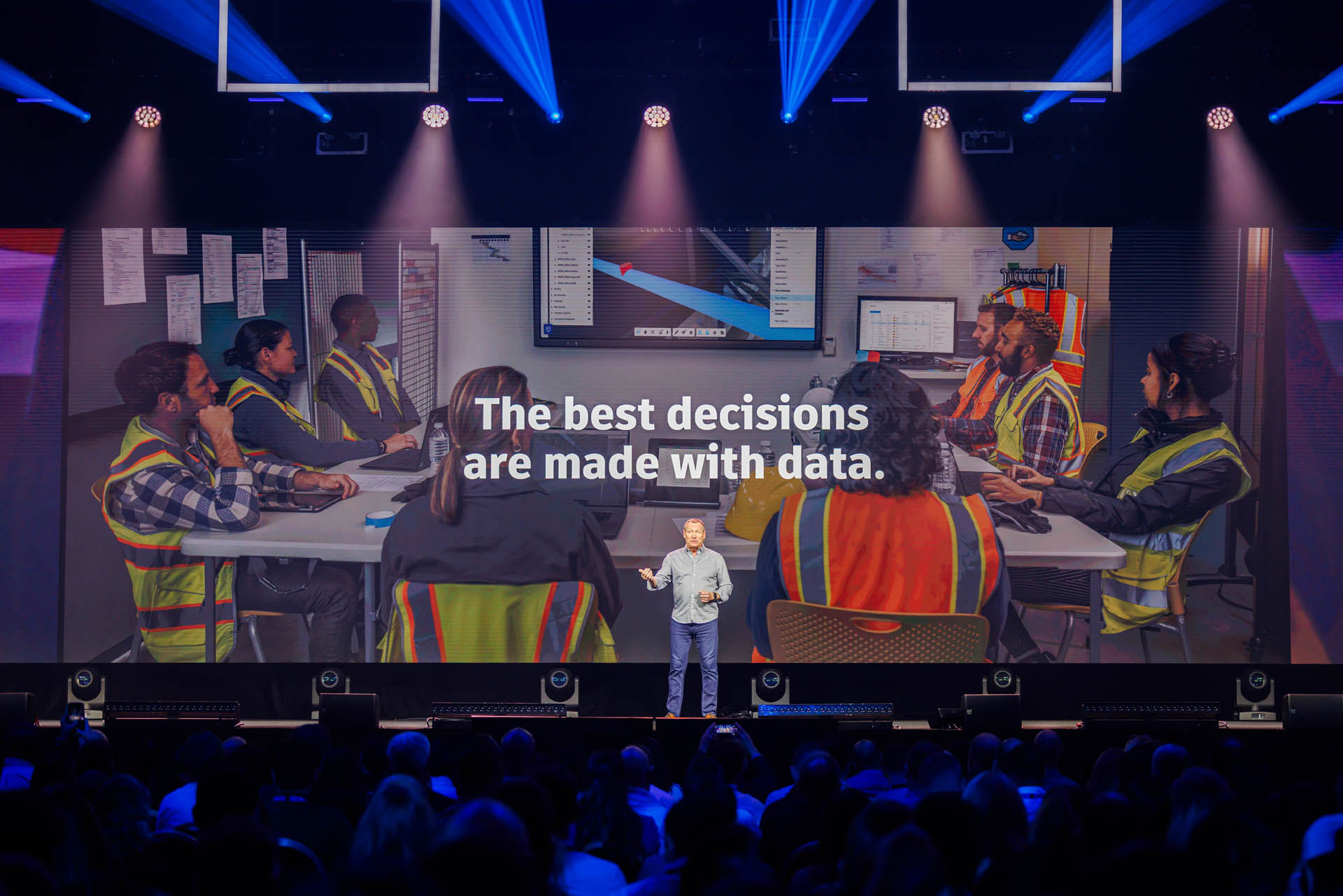
Outcome-based BIM
The AI theme continued with Nicolas Mangon, VP of AEC industry strategy. He emphasised how AI needs data to train and said, “As Autodesk AI learns about how you work, the context of your projects, and your desired outcomes, it will help you develop better and more sustainable results for you and your clients.
He explained that for AI to work effectively, it needs to learn and to learn, it needs accessible data, a lot of data! “That is where we see the most potential to transform our industry,” he said.
Much has been said in industry about data being the new oil. “Well, today, we have an oil boom,” said Mangon. “There are over 15 billion files created by Autodesk software. And these files contain data from existing conditions, past and current projects, GIS, IoT sensors, workplace management systems, stakeholder sentiments, whether geotechnical, pollution etc.”
Much of that data is high value for AEC firms, he said, and “also for Autodesk AI to leverage.”
“It’s not going to be Revit or Forma, it’s going to be Revit and Forma working together. So now with atom-based BIM, Autodesk will augment your capabilities and will co-create with you.”
Nicolas Mangon, VP of AEC industry strategy
“Imagine being able to run your project reviews within a full virtual experience, bringing together the real-world context data with your project, or to create a digital twin of a metro station that uses IoT data to trigger maintenance algorithms. These kinds of capabilities are only possible when data is precompiled and broken into logical, granular elements.”
The problem, as Mangon sees it, is that data is locked inside these files and models and Autodesk’s customers realise this. Autodesk’s new strategy will be putting all the data in one central repository, Autodesk Docs.
Mangon claimed that Docs was open, secure and accessible. The data within Docs will be stored granularly, at the object level and will be ‘decoupled’ from applications and file. This means the data can move from application to application, or team to team. For instance, data created in Revit, is no longer tied to one application to ‘load it’.
“In doing this, we are freeing data to fuel AI and this AI will give you an additional and new way of working,” he said.
Autodesk is calling this new way of working ‘Outcome-based’. “This is not a replacement of product testing that you’ve been doing for many years with Navisworks. Revit and Civil 3D. It’s a powerful additional capability that will complement your model-based approach,” said Mangon.
“It’s not going to be Revit or Forma, it’s going to be Revit and Forma working together. So now with atom-based BIM, Autodesk will augment your capabilities and will co-create with you.”
Mangon made the point that the longer firms wait to make a decision, the more expensive and disruptive the decision becomes. “What if you could immediately see the impact of your decisions?” he the best sun exposure for a rooftop swimming pool,” adding that Forma’s real time analysis capability, based on predictive AI, gives users that ability.
“It’s like a crystal ball,” he said. “And it’s available right now with the outcome-based BIM, since we define their desired outcomes from the very beginning of a project, and then we’ll ask Autodesk AI to help them identify not the first or second option, but the best option, all in one environment without users having to convert models or build new ones for analysis workflows.”
Mangon believes these capabilities will reimagine how the AEC industry works across all disciplines and project phases, while connecting current model-based BIM workflows.
“As we continue to build out Forma, we will support more and more outcomes,” he said. “Things like building performance, sustainability, industrialised construction, structural resiliency, cost or even social impact.
“Outcome-based BIM will help you deliver on more projects and develop better assets for your clients. To truly realise the evolution of BIM that we are envisioning with Forma, we recognise that our open ecosystem approach must embrace more tools across the industry. That’s why we are opening up our platforms so that anyone you, Nemetschek, Trimble, Ansys, McNeel, can contribute to seamless exchanges of information.”
Automation of design
Racel Amour, Autodesk’s AI development manager, picked up the AI story, focusing on the automation of design. “We’re on the verge of industry transformation, like you’ve never seen before”, she said. “As compute power and data stores grow, AI has finally scaled to where it can train against the complexity of 3D models. And the user experience has improved to the point where the technology finally feels accessible.”
Originally an architect, Amour headed up the development of Forma’s rapid operational energy analysis tool, which helps designers understand the carbon impact of a building’s design in real-time, as the design changes.
It’s possible to optimise the building’s energy efficiency and performance at the very beginning of the project, when decisions have the most impact on time and money. Results are delivered in a matter of milliseconds without having to interrupt the design flow while simultaneously running analysis.
Autodesk really is banging the open drum – open APIs, open formats, cutting deals with competitors for mutual data access, even inviting competitors like Snaptrude to exhibit at AU
Amour ran through a few other sprinkles of AI in Autodesk products, such as AI-powered smart blocks in AutoCAD and Dynamo’s node autocomplete which uses machine learning that’s been trained on years of real Dynamo graphs.
Autodesk is currently working on an AI-powered chat-bot called Auto AI. Auto AI leverages large language models to understand AEC terms, processes and rules, as Amour explained, “Imagine a future where a cost estimator could simply ask Auto AI, ‘Can you build me the door schedules for all the buildings in my project, then use that information to quickly estimate the cost of the doors’. That’s game changing!” Auto AI will go into beta-testing next year.
Handover to construction
Lalith Subramanian, Global VP, product and engineering presented the latest developments from Autodesk Construction Cloud, including a new fast mobile viewing platform which can handle huge models, which is currently in beta. In the same pre-construction vein, Subramanian talked about Navisworks, which he said was so popular that ‘some people have decided to even try to copy it’, probably as a reference to Revizto, Verifi3D and a slew of other tools. We would probably say here that the industry moved on while Navisworks didn’t, but there now seems efforts to concentrate on this area of VDC within the construction team.
AI raised its head here too, with Subramanian stating, “We’ve been doing AI for a while, and you’ve already been using it. Autodesk brought AI to construction five years ago with Construction IQ. More than 12,000 projects have already taken advantage of construction IQ.
“Construction IQ uses AI to analyse data, and give you critical insights on project risk. Crucial information from the quality of work to the safety of your teams. Your project leaders are no longer having to sift through thousands of issues. Construction IQ instead uses that AI to help them find the ones they need to resolve first.”
ACC also uses AI to automate manual work, such as symbol detection in drawings, saving hours in take offs. With an upcoming specification tool, machine learning will automatically take a spec and organise it into important sections. Autodesk is also developing new AI for intelligent search and ‘chat’ with ACC. “In a future release, you’ll simply be able to ask ACC, how much time does my concrete need to cure before I can build on top of it? It will give you an answer,” explained Subramanian.
Conclusion
At AU, the big push for AEC was obviously AI, Forma and, surprisingly, Autodesk Docs. We felt that the original launch of Forma back in May pulled its punches. The presentations at AU made up for that. It’s pretty clear the new Unified Database or Autodesk Data Model is now the technology which lies underneath Docs and will become ever more important to every customer as Autodesk moves to be more cloud-first with its actual applications, as everything eventually becomes a cloud service.
If Arcadis has been testing Forma, Revit and Docs, and if all goes well, Forma might be available for general use as early as Spring 2024. This will be interesting as RVT ‘files’ will be translated and stored on the fly within the new granular database. This means huge globs of customers’ Revit data can be stored in the new data format, potentially leading to swathes of data to train AI on. How free customers will decide to be with their data remains to be seen. We explore this in more detail below.
Granular data also potentially means a whole new range of cloud applications that can be integrated through APIs to access project data, as opposed to having to sit on top of desktop Revit.
AI for existing developers with evolving or mature platforms are more likely to be applying AI with light sprinkles here and there, as Autodesk has done.
The danger to Autodesk is that a startup firm with no legacy is going to come along and punch out parts of today’s workflows. With so many now chasing the prize of truly automating drawings in AEC, what would a cloud-based app that converted models to drawings (to the exact specifications of the user) do to today’s software developers?
How many 2D CAD seats would be needed? As today’s BIM tools are focused on modelling to produce drawings, how many BIM seats too?
Autodesk really is banging the open drum — open APIs, open formats, cutting deals with competitors for mutual data access, even inviting competitors like Snaptrude to exhibit at AU.
Despite having built on the benefits of the popular proprietary formats of DWG and RVT, Autodesk really seems to mean it, and is backing up the words with actions.
The whole idea of Suites, Collections is to keep customers within the ecosystem. With truly open API access, customers will be more free than ever to choose to build tech stacks on best in class solutions, which will not all come from any single vendor. Is this extreme confidence in these new cloud-services and collaborative granular workflows, perhaps the AI code that’s in development? Autodesk seems intent on levelling the playing field on which it had a distinct and tightly held advantage.
Elsewhere, Mangon’s framing of outcome-based BIM was an interesting take on performance-based design.
The amount of coverage that the company gave to Forma at AU was exceptional. Up to this point, conceptual design was pretty much based on massing models and building envelopes. Now there are a range of tools to examine conceptual designs with real time analysis tools, to refine and qualify design ideas.
Autodesk is in the position of having to evangelise new capabilities and technology which the vast majority of users have not had access to as part of their collections.
While talking with your design software might be holy grail of design, Autodesk, and the industry, has a long way to go before it really creates an allknowing AI to design buildings.
What we can see today, are discrete capabilities driven by machine learning and AI to give design feedback on specific aspects.
Amour gave a tantalising insight into the ability of asking the software to interrogate and format queries and documentation which typically take ages to prepare. Autodesk obviously wants to go deeper and broader with artificial intelligence across its AEC applications. It first needs to cross the large dataset issue with the owners of that IP, then the ultimate aim seems to also be to look to extend the opportunity for customers to train AI assistants, based on their own project data. So generic AI to specific AIs.
Concerns around Autodesk AI
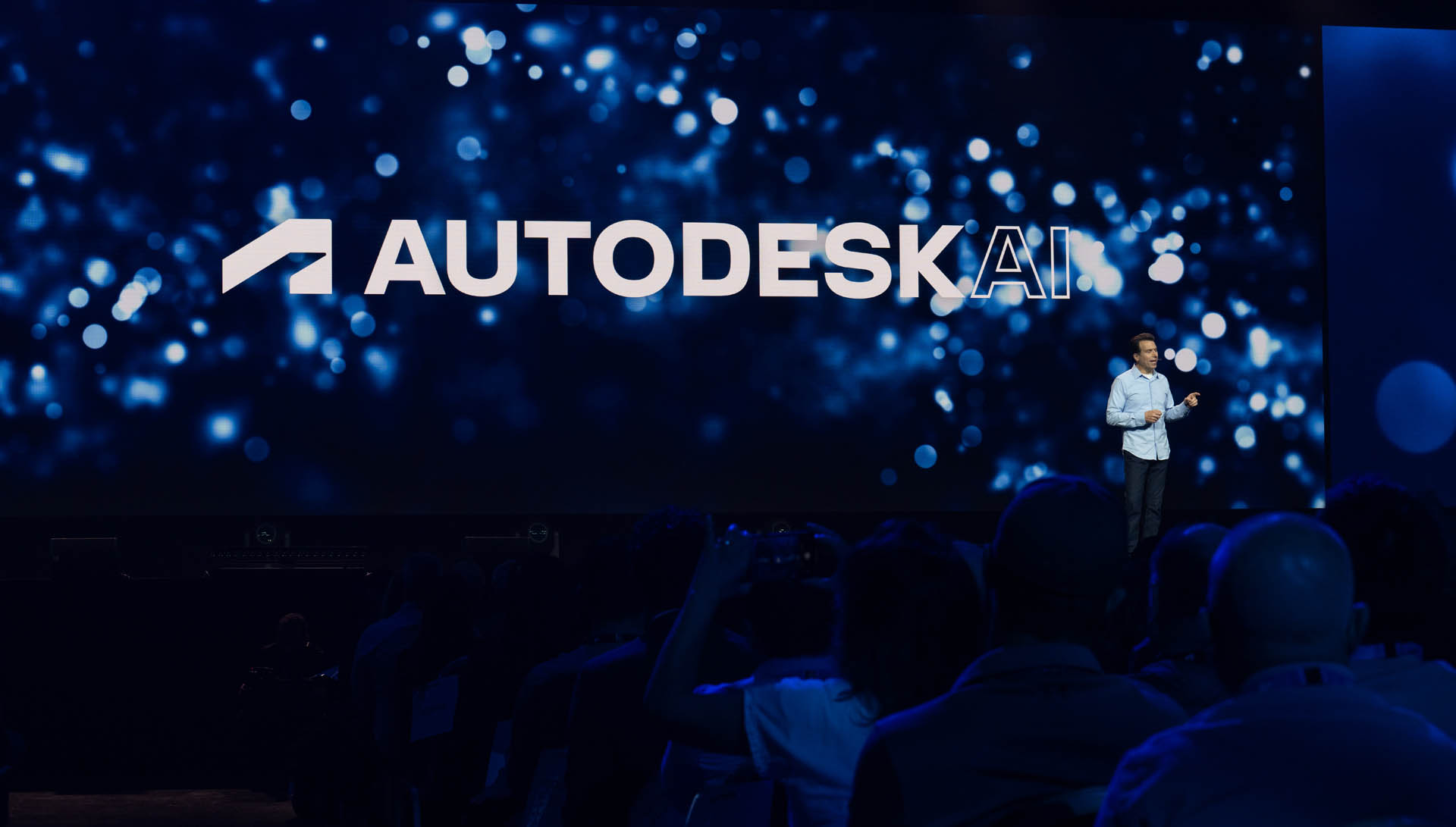
Fear of AI has been widely acknowledged, but having watched the presentations at AU, some firms have since expressed concern that their hosted project data could used by Autodesk AI for training and used to develop Autodesk products and services.
As AI requires large amounts of data to learn from, Autodesk is claiming that it has it all. With so many presentations referencing the huge amount of data that Autodesk hosts, perhaps it didn’t truly consider the impact that these words might have on its users?
But this data is the IP of its customers. It would be a bit like OpenAI presenting to all the book authors of the world, and saying we will train our AI on your IP.
AI and IP abuse is one of the key areas that governments are highly interested in protecting and introducing legislation on. There are many architecture firms that absolutely do not want their data used to train any generic Autodesk AI.
Some have started going through the Autodesk EULAs (End User Licensing Agreements). Having had a cursory look ourselves, there doesn’t seem to be any specific clause giving Autodesk explicit access to customer data for AI training, but in the Terms of Use in the Special Terms segment for Autodesk Construction Cloud, Autodesk Build, BuildingConnected, PlanGrid, ProEst, Pype, and TradeTapp products, there is this wording:
“In addition to any rights granted in the General Terms, Autodesk may also perform certain data analytics or other analysis on Your Content, use the resulting data and insights for our internal purposes, and disclose insights derived from Your Content on an aggregate and anonymous basis to third parties or publicly. Autodesk will not disclose specifics about Your Content except to You as part of the Offerings at Your direction or upon Your consent.”
There are many architecture firms that absolutely do not want their data used to train any generic Autodesk AI
While we are not lawyers, it could be interpreted that Autodesk has the right to run analytics, to train and improve software, although we are not sure if this applies to Autodesk BIM 360 or Docs.
From the presentations many would infer that Autodesk is going to access and use a wealth of customer information for some deeper insight. There already is a long list of tech companies that are rushing to give themselves the right to use people’s data to train their AI – X, Microsoft, Meta, Zoom have all updated their EULAs to broaden their licence to access public or private data to train and maintain proprietary AI models, using vague language. In the case of Zoom, due to kick back from customers who were alerted that their calls would be listened to, the company had to make a hasty retreat.
In the press conference, CEO Andrew Anagnost was asked about customers’ IP and AI by industry consultant Allan Behrens. Anagnost replied, “It’s not ‘our’ data it’s their data. And we work with them to decide what we should train on and what we shouldn’t.
“I think the discussion here is what’s the intent? Our intent is not to train models that take the secret sauce of some of their intellectual property and expose it to the rest of the world. Our intent is to train models that allow people to build 3D representations, detailed 3D representations of their ideas, faster. That helps everyone. So initially, what we’re going to be doing is we’re going to be training on datasets that represent a broad set of how a model is assembled, not how a particular system is designed.
“Now it doesn’t mean we won’t get to how a particular system is installed. But once we get into the systems level, I think we’re going to have a very different relationship with our customers. And it’s going to be one where we got this foundation model and rapidly creates models. Do you want a systems solution for you? Here’s your version of that model. Let’s train a system solution for you. And that is a very different approach. That’s where the IP comes in, because it’s in the systems thinking and how you integrate these things and where some of the novelties are created.
“We really care a lot about this. We care about doing this right and bringing the customers along.”
Later in the press session, Anagnost added, “We have to get people comfortable with how much of your data do you want to share with the greater good versus what you want to keep for your own proprietary abilities. That’s part of the mindset shift that has to happen, because it really is hard to create the first iteration.”
For Anagnost making that first foundational AI model will be key, as he explains “Those who understand the AI ecosystem, know creating a foundation model is incredibly expensive, refining a foundation model is not.
“Once you get to a point where the model is intelligent enough to glean the abstract concepts, putting more abstract unstructured concepts into it trains the model better and at significantly less cost.”
At the AEC press conference, Jim Lynch, executive VP Autodesk construction solutions and a key proponent of Construction Cloud, explained that because firms have issues with having their data trained on ‘we really look at single customer’s data’. “We don’t anonymise a bunch of data and look at it that way,” he said. “I think it’s unfortunate, because I think when we can do that, when our customers say yeah ‘anonymise our data’, I think it’s going to drive greater outcomes for all of our customers, because all of a sudden, now our algorithms are learning from a very, very, very large data set. We’re not there yet.”
It’s clear that Autodesk knows the value of having a huge amount of customer data, and it wants to develop AI tools based on this data. But it also seems to recognise that not all customers want to share. For now, it’s engaging with individual firms, who give their permission, as in Construction IQ or ACC in return for specific benefits. It will be interesting to see how it engages with customers to make that first leap to build the underlying AI model.
Either Autodesk feels it has this covered in the existing EULA, or it just accepts it has to do engagements on a case-by-case basis. Of course, there is always the option of updating the EULA in the near future, for all customers.
The bold aspirations of having data-galore for training AI communicated on the mainstage presentations, didn’t quite match the caution expressed by the executive team in the press conferences under questioning. It will be interesting to see this evolve and how customers react.
Maybe this was Autodesk trying to get the discussion going ‘if only we could access all your data, imagine what we could do?’ The problem is, when it comes down to a generic AEC AI, customers are more concerned about negatives than positives, at the moment.
Keeping one eye on manufacturing
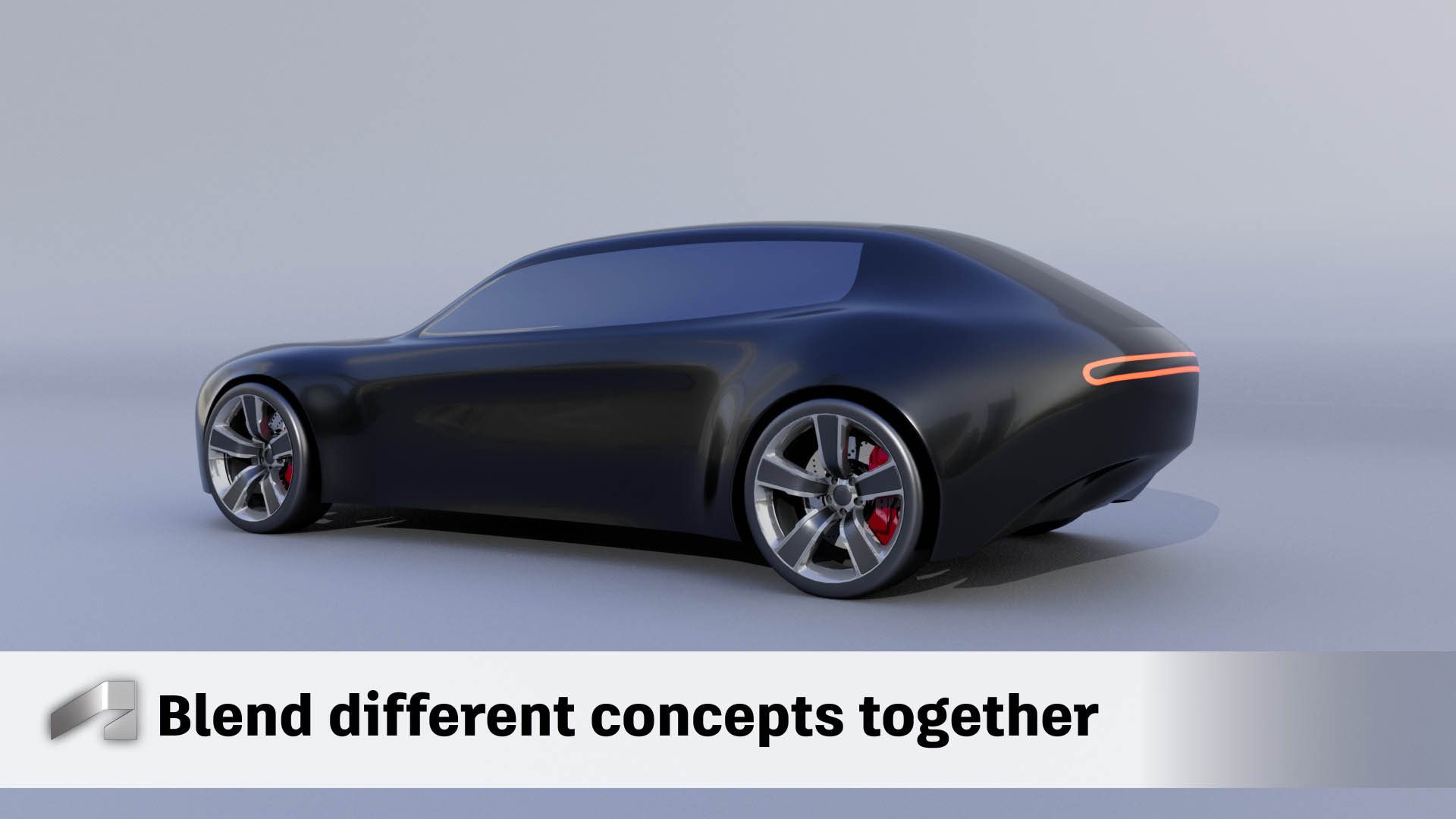
While AEC Magazine focuses on architecture, engineering and construction, there is always much to learn from Autodesk’s manufacturing division.
Jeff Kinder the EVP for product development and manufacturing solutions, provided interesting facts on how Fusion, Autodesk’s oldest cloud-based modelling tool, and its ecosystem had panned out.
This should be of particular interest to AEC / Revit customers that might be struggling to get their heads around how Forma will develop and replace their current desktop-based tools in the future. Fusion is the poster child for Autodesk’s cloud-first future.
Kinder explained that the automotive industry is in the midst of a once in 100-year change, moving from fossil fuels to electric platforms. One of Autodesk’s customers, Rivian, is using the full Fusion techstack to connect the design and production engineers, with design data flowing seamlessly.
Autodesk Fusion is ten years ahead in cloud development compared to all of Autodesk’s other verticals. It breaks silos, means designs can be managed, distributed, iterated faster, simulation-enabled, including electronic design, 3D print, CNC and VR (or mixed reality) – all cloud-based.
On AI, Kinder stated, “By the end of the year, we will launch automated drawings in Fusion to translate your 3D models into fully dimensioned drawings with a click of a button”. This is one of the top asks from delegates at AEC Magazine’s NXT BLD and NXT DEV events and there are now many software firms seeking to develop this for AEC. It’s total conjecture but we assume Autodesk is also working on this for its AEC customers. It would be better to disrupt its own sales of AutoCAD and LT, than have someone else do it to them. Bentley Systems, Swapp, BricsCAD and Graebert are all actively looking to apply AI to drawings.
Kinder also talked about the recent acquisition of BlankAI for conceptual design which is a generative AI technology which augments the work of automotive / industrial designers, enabling them to create 3D concepts in milliseconds.
The AI lets users generate and edit proportional 3D models via semantic control and even allows automotive firms to incorporate their own historic design DNA in the AI. It’s very impressive.
BlankAI will be debuting in Autodesk’s automotive design studio next year and while the main focus is currently on automotive, Stephen Hooper, vice president of design and manufacturing at Autodesk, says there’s no reason it couldn’t be applied to other products, such as furniture or packaged goods. We wonder if this technology could also be applied to buildings.
Main image: Jim Lynch, executive VP Autodesk construction solutions on the stage at AU
Construction IQ footnote – to learn more about the AI capabilities in Construction IQ read our 2019 article which explored how BAM was using the software when it was part of Autodesk BIM 360. It has since become a capability within Autodesk Construction Cloud (Autodesk Build).

